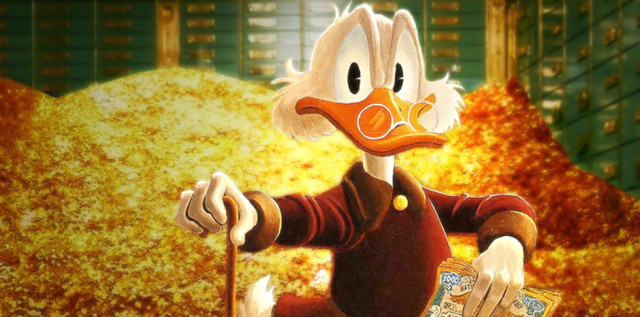Lessons from the Richest Duck in the World by Robert Anthony Peters
Scrooge is an unlikely name for a hero. Since Dickens’s A Christmas Carol, it has elicited thoughts of disagreeable skinflints. That all changed with Scrooge McDuck.
At first, Donald Duck’s Uncle Scrooge was quite Dickensian in character, but creator Carl Barks knew that a churlish miser would not sustain an audience’s sympathy. To really give this character legs (or wings), he would have to give him the kind of morals that resonate with readers.
It worked. Disney’s Duck universe has been popular for over 60 years. My generation enjoyed Duck Tales on TV. An older generation avidly read Uncle Scrooge comics, the first issue of which has Scrooge explaining how he earned his fortune: “I made it by being tougher than the toughies, and smarter than the smarties! And I made it square!”
Barks created a wealth of economic lessons through fables that are still enjoyed around the globe today.
A Modern-Day Aesop
Barks was born in rural Oregon to a farming family at the turn of the 20th century. Growing up, he had a hardscrabble existence. Due to several moves, living far from schools, and poor hearing from childhood measles, he had minimal education. He worked as a farmer, cowboy, swamper, railroad worker, printer, and more. His first gig as an illustrator was for a men’s humor magazine. In late 1935, he discovered an ad in the newspaper for Disney. Though the job offered only half his current pay, he decided to join the animation department and eventually the comic book publisher. Barks was a man who was willing to work hard, work well, and take a chance on great possibilities. The storytelling in these comics featured Barks’s strongly individualist outlook, his belief in the entrepreneur, and his optimism in markets resulting in human benefit.
Trade, Trade Again
Before Barks created Uncle Scrooge, he was already exploring the beneficial nature of trade in 1947’s “Maharajah Donald,” an issue of the Donald Duck comic book series, which featured Donald and his nephews Huey, Dewey, and Louie. The story begins with the boys cleaning out the garage at Donald’s behest, with the understanding that they could keep whatever he did not want. Predictably, he wanted all the things and was only willing to part with one stub of a pencil that’s “not worth a thing.” Less than thrilled, the boys keep it to trade for something else. They run into Piggy, who offers them a ball of string. Figuring it is not worse, they trade. As luck would have it, they run into a kid whose kite flying is limited by his length of string. Eager to get it really soaring, he trades them his knife for their string. One of the nephews feels a pang of guilt, but in short order, the other two chime in, “Don’t let it bother you” because “he’s happy!”
Eventually, they trade up to a pearl and decide to cash in. There happens to be a man in the jewelry store who was about to sail to India to obtain a pearl much like what they have in their hands. They exchange it for the steamboat ticket, which Donald promptly steals from them. Donald boards, the nephews stow away, and they arrive in India, only for Donald to run afoul of the local magistrate to the point of being fed to the royal tigers. While wracking their brains to find ways to save him, his nephews run over their list of assets: “We don’t know a soul we could ask for help … and we haven’t a cent for bribing the guards … we just can’t do something that is impossible.” But lo and behold, what do they spy next but an old stub of a pencil! To which the nephews declare, “We’re rich!” They then commence trading goods until they have acquired a creative solution to free their uncle from his predicament.
The story presents a cornucopia of economics lessons: subjective value, mutual gains from trade, and entrepreneurship. What better display of subjectivity than to have your life saved by the application of market exchange to a good that you considered worthless? Mutual gains are clear by the voluntary nature and perceived benefit of each party to the trade. (Most poignant is the Kirznerian alertness to the pencil and its use in trade.)
A Land without Greed
“Tralla La” is the tale of an exasperated Uncle Scrooge. Tired of being hounded for his wealth and time by charities, businessmen, and tax collectors, he finally snaps, telling Donald, “I want to go someplace where there is no money and wealth means nothing!” From his physician, he hears of the land of Tralla La, a land without gold, jewels, or money, deep in the Himalayas. Scrooge, Donald, and nephews set forth, and as they fly overhead, they see a land of abundance. The leader explains, “We Tralla Lallians have never known greed! Friendship is the thing we value most!”
All is serene until a farmer discovers a bottle cap that Scrooge had carelessly tossed out of the plane window. The honest peasant attempts to return it to Scrooge, who declines it, considering it worthless. Subjective value makes its appearance here, when the farmer and his fellow villagers invest this item with great desirability, leading to a bidding war that goes from 10 sheep to 20 and finally to a year’s yield of rice. When it is discovered that Scrooge has a case of bottles, all with caps, the Tralla Lallians attempt to purchase it, to no avail. Finally, the mob declares him a “meanie” and wants his taxes raised. The only solution to this problem is to call in an air strike — not of bombs, but bottle caps.
Even a humble bottle cap can spark desire because of its scarcity. Its price will be high if it is the only one around and perceived to have value. The results of “Helicopter Ben’s” strategy are on display here as well. Though the Federal Reserve may believe that it can make people wealthier by increasing the money supply, Uncle Scrooge knows that increasing the number of bottle caps will diminish their worth.
From Riches to Rags to Riches
Finally, and probably the most famous Uncle Scrooge story in economics circles, we have “A Financial Fable.” Beginning as a bucolic idyll, the story opens with the entire Duck clan working the fields and tending the livestock. The nephews sing the praises of hard work while Donald complains, wanting money for nothing.
Scrooge investigates his new bank, a corn crib, hiding his money in plain sight. This may not have been his brightest idea: a cyclone whips through and takes all of his money, scattering it over the countryside. The nephews are distraught, but Scrooge simply replies, “If I stay here and tend to my beans and pumpkins, I’ll get it all back.”
Donald and the rest of the country quit their jobs and set off to “see the world.” Meanwhile, Scrooge and the boys continue to labor on their farm. With no one else working and nothing being produced, Donald and the rest of the world come straggling back. Scrooge is happy to feed them — at new market prices. Eggs are a million dollars apiece, cabbage is two million, and ham is a bargain at a cool trillion. With each purchase, the money from Scrooge’s corn crib trickles back and he becomes, yet again, the richest duck in the world.
With another “helicopter” scenario, we see the inflationary effects of a massive injection of money. We also get a glimpse into many aspects of wealth — how it is created, how it is maintained, and what happens when we redistribute in ways that are not related to market performance. Barks knew he was creating a morality tale of capitalism, admitting, “I’m sure the lesson I preached in this story of easy riches will get me in a cell in a Siberian gulag someday.”
Economic Tales
Economics is all around us — even in our comic books.
Now cable channel Disney XD has announced plans to relaunch Duck Tales in 2017. As long as the show sticks to the characters and stories inspired by the great Carl Barks, it will offer us plenty to enjoy — and economics lessons that are sure to fit the bill.
Robert Anthony Peters is an actor, director, producer, and member of the FEE alumni advisory board.














